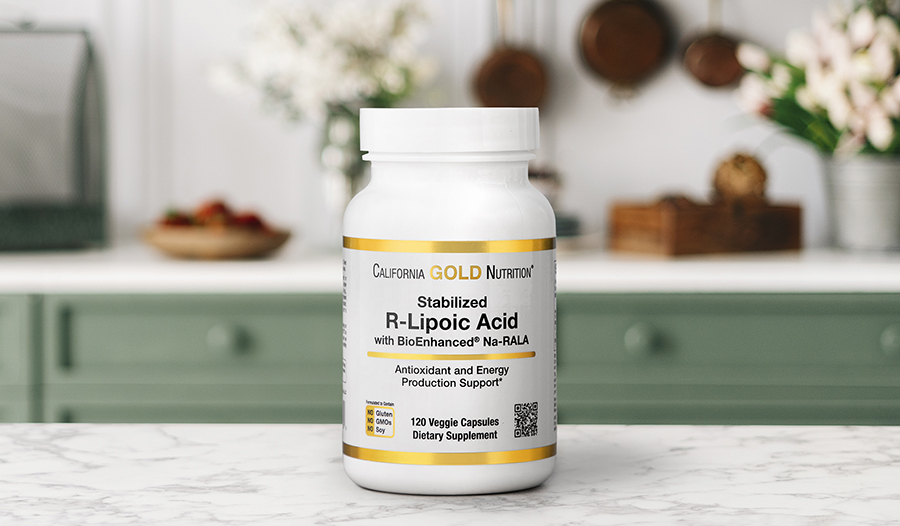Alpha-Lipoic Acid Might Be Nature’s Perfect Antioxidant—Here’s Why
DISCLAIMER:This blog does not intend to provide diagnosis...
- In this article:
- What Is Alpha-Lipoic Acid?
- Key Functions of Alpha-Lipoic Acid
- Are There Different Forms of Alpha-lipoic acid?
- What Are the Benefits of Alpha-Lipoic Acid?
- Is Timed-Release ALA Necessary?
- Side Effects, Safety, and Drug Interactions

What Is Alpha-Lipoic Acid?
Alpha-lipoic acid (ALA) is a unique vitamin-like compound often described as “nature’s perfect antioxidant.” While ALA can be made naturally in the body, sometimes synthesis does not meet demand, and supplementation is required.
Alpha-lipoic acid is a cofactor or coenzyme for at least five enzyme systems. This means that the enzyme cannot perform its required function without ALA. Two of these enzyme systems are involved in energy production, while the others are involved in detoxification and the transport of fatty acids. Not surprisingly, low cellular levels of ALA are associated with cell damage and dysfunction due to a lack of ATP and the antioxidant protection offered by ALA.
Since ALA is a tiny molecule, it is efficiently absorbed and easily crosses cell membranes. Unlike vitamin E, which is primarily fat-soluble, and vitamin C, which is water-soluble, ALA can quench either water- or fat-soluble free radicals inside and outside the cell. Furthermore, alpha-lipoic acid extends the biochemical life of vitamin C and E as well as other antioxidants.2
Key Functions of Alpha-Lipoic Acid
- Alpha-lipoic acid is necessary for the manufacture of adenosine triphosphate (ATP)
- ALA acts as an important cellular antioxidant
- ALA helps to reduce markers of inflammation1
Are There Different Forms of Alpha-lipoic acid?
Alpha-lipoic acid (ALA) exists in two forms, one that contains the natural R form, known as R-ALA, and another that is often simply referred to as ALA that contains a mixture of the R and S forms. The R and S designation refers to the orientation of the molecule. They are mirror images of each other. The R form is the natural form of ALA that is utilized by the human body. The S form is a synthetic form that the body does not use in any tenzymatic processes. ALA supplements contain either a 50/50 mixture of the R and S form, which can be designated R,S-ALA, or the purified R-ALA form.3
If the supplement is listed only as ALA on the label, it should be assumed that it is the R,S-ALA form.
ALA supplements are best taken on an empty stomach to enhance absorption.4
What Are the Benefits of Alpha-Lipoic Acid?
Because of its potent and unique antioxidant activities, Alpha-lipoic acid (ALA) has long been used to promote good health. It has shown an ability to boost antioxidant protection, detoxification, and liver health, support blood sugar control and healthy nerve function, enhance metabolism, aid in weight loss, and protect against aging.4
Antioxidant, Anti-Aging, and Detoxification Effects
ALA may help support healthy aging by increasing antioxidant levels by influencing gene expression. Specifically, ALA activates a compound known as Nrf2, which orchestrates a complex regulatory network that affects metabolism, mitochondrial function, and inflammation.5
Nrf2 has been called the “guardian of the healthspan and gatekeeper of longevity,” because it protects the cell against damage and aging.6 One of the reasons Nrf2 produces these benefits is that it is a powerful activator of an enzyme known as NQO1 that is critical for several reactions in cells. Too little NQO1 is associated with impaired detoxification, lower energy levels, and altered cellular function. Among its critical reactions, NQO1 converts CoQ10 from its inactive form (ubiquinone) to its active form (ubiquinol).
ALA also helps repair oxidized proteins, prevents age-related inflammation, supports mitochondrial health and energy production, and boosts glutathione levels. Pre-clinical studies also show that ALA addresses many of the other underlying features contributing to memory loss and cognitive decline.7
ALA protects the liver from free radical damage and also helps promote detoxification reactions. ALA increases the production of glutathione, the body’s chief cellular antioxidant and detoxifying compound. ALA also helps eliminate heavy metals from the blood (lead, mercury, cadmium, etc.). Preliminary clinical evidence has shown benefits in supporting liver health.4
A critical aspect of antioxidant activity in the body is the level of ALA, glutathione, and other sulfur-containing molecules. In their active form, these molecules can bind act as detoxifying and antioxidant compounds. But they also exist in an inactive form. Therefore, the ratio of active to inactive sulfur molecules is a key marker of antioxidant status. The higher the level of active sulfur molecules, the greater the protection.
Nerve and Brain Function Support
ALA has also been shown to protect the structure and function of the blood-brain barrier. Typically, this protective barrier prevents the passage of large molecules and white blood cells into the brain. If the blood-brain barrier is damaged, it leads to significant inflammation within the brain. ALA has also shown the ability to inhibit the formation of various compounds associated with promoting inflammation within the brain.9
Human clinical studies have shown ALA to protect nerve tissue and the brain. Some of these studies have been performed in people with multiple sclerosis (MS), a condition characterized by a loss of the myelin sheath surrounding nerve fibers.9 The myelin sheath is critical for the transmission of the nerve impulse. Hence, in MS there is a significant disruption of nerve function. The clinical studies of ALA in MS have used dosages as high as 1,200 mg per day (R,S-ALA). Supplementation with ALA showed to improve nerve function and reduce the levels of matrix metalloproteinase 9 (MMP-9) and cytokines. Both are markers of nerve inflammation and damage.10,11
One of the longest uses of ALA supplementation has been in improving nerve structure and function in patients with diabetes-associated neuropathy. Numerous human clinical trials have demonstrated the benefits of ALA supplementation in these subjects.4,12,13 In a 4-year double-blind study of 460 diabetic patients with mild-to-moderate neuropathy, subjects who received 600 mg of ALA per day demonstrated significant improvement and prevention of progression of neuropathy.12 Improvements are generally seen within three weeks of supplementation of 400 to 600 mg of R,S-ALA. Some of these benefits may be due to improved control of blood sugar levels (discussed below).
Blood Sugar Control Benefits
ALA may also help improve blood sugar control and insulin sensitivity. Since oxidative stress plays a significant role in insulin resistance and loss of blood sugar control, ALA addresses this factor. And since ALA also facilitates the conversion of glucose into energy, there are additional beneficial actions. Clinical studies in humans have confirmed ALA improves insulin sensitivity and reduces insulin resistance, improves blood sugar control, lowers oxidative stress, and improves vascular health. Improvements in blood sugar levels and insulin sensitivity are observed within one or two weeks of starting ALA supplementation.14,15
Metabolism and Weight Loss
Pre-clinical studies indicated that ALA may help to boost metabolism, promote the burning of fat as energy, reduce food intake, and potentially aid in weight loss. Several clinical trials have been conducted to clarify the weight loss-promoting effects of ALA. For example, in one double-blind study, 97 overweight or obese women were put on a weight-loss-promoting diet of 30% less than total energy expenditure. One group served as the control group the others were given either ALA 300 mg; a fish oil providing 1.3 g EPA; or the combination of ALA 300 mg and EPA 1.3 g.16
The study lasted ten weeks, and the control group lost an average of 11.44 pounds; the EPA group 11.88 pounds; the ALA group 15.4 pounds; and the ALA+EPA group 14.3 pounds. Hence, ALA supplementation alone or in combination with EPA enhanced the effects of dieting. ALA contributed approximately 3 pounds of extra weight loss over the ten weeks. Weight loss was associated with positive changes in lipid and glucose metabolism.
There are a couple of essential points to consider from this study. Most importantly, all subjects were placed on a reduced-calorie diet, which allowed even the control group to lose weight. The effect of ALA was to promote additional weight loss. Studies, where ALA was simply given to subjects wanting to lose weight, did not promote significant weight loss even if the dosage was 1,200 mg per day though there were improvements in waist circumference. Nonetheless, a detailed meta-analysis of 8 studies in weight loss concluded ALA supplementation significantly reduced BMI and waist circumference.17
Is Timed-Release ALA Necessary?
Alpha-lipoic acid (ALA) is available as a regular immediate-release product as well as a timed-released form. The existing evidence does not seem to support an advantage to taking a timed-release product. It looks like immediate-release formulations are better utilized. ALA is quickly absorbed with roughly the same percentage, whether the dosage is 50 or 600 mg. The absolute bioavailability of ALA indicates about 93% of the dosage is absorbed no matter what the dosage.4,18
While timed-release ALA is absorbed more slowly, that may not be a good thing as ALA appears to gain the most significant clinical benefits with oral ALA what is required is that the dosage flood or overwhelm the liver’s ability to grab hold of the ALA and thereby allowing it into the general circulation leading to rapid elevations in blood levels and delivery to other vital tissues. This goal appears best achieved with immediate-release products, and it is probably best to take the dosage once a day versus in divided dosages.4,18
Side Effects, Safety, and Drug Interactions
ALA is generally well-tolerated and without side effects. The most common side effect is mild gastric irritation or nausea. This uncommon side effect is reduced even further with the use of R-ALA.3
ALA is also highly safe as dosages of up to 2,400 mg daily produced no significant side effects. Minor gastrointestinal symptoms (such as nausea and upset stomach) a headache, and minor skin symptoms (primarily itching sensation, urticaria, or symptoms of allergic skin conditions) have been reported.19
ALA supplementation may require dosage adjustments for insulin or oral hypoglycemic drugs like metformin to improve insulin sensitivity and blood sugar control.
References:
- Vajdi M, Mahmoudi-Nezhad M, Farhangi MA. An updated systematic review and dose-response meta-analysis of the randomized controlled trials on the effects of Alpha-Lipoic acid supplementation on inflammatory biomarkers. Int J Vitam Nutr Res. 2021;1-14.
- Rochette L, Ghibu S, Richard C, Zeller M, Cottin Y, Vergely C. Direct and indirect antioxidant properties of α-lipoic acid and therapeutic potential. Mol Nutr Food Res. 2013;57(1):114-125.
- Cameron M, Taylor C, Lapidus J, Ramsey K, Koop D, Spain R. Gastrointestinal Tolerability and Absorption of R- Versus R,S-Lipoic Acid in Progressive Multiple Sclerosis: A Randomized Crossover Trial. J Clin Pharmacol. 2020;60(8):1099-1106.
- Salehi B, Berkay Yılmaz Y, Antika G, et al. Insights on the Use of α-Lipoic Acid for Therapeutic Purposes. Biomolecules. 2019;9(8):356.
- Elangovan S, Hsieh TC. Control of cellular redox status and upregulation of quinone reductase NQO1 via Nrf2 activation by alpha-lipoic acid in human leukemia HL-60 cells. Int J Oncol. 2008;33(4):833-838.
- Lewis KN, Mele J, Hayes JD, Buffenstein R. Nrf2, a guardian of healthspan and gatekeeper of species longevity. Integr Comp Biol. 2010;50(5):829-843.
- Seifer F, Khalili M, Khaledyan H, et al. α-Lipoic acid, functional fatty acid, as a novel therapeutic alternative for central nervous system diseases: A review. Nutr Neurosci. 2019;22(5):306-316.
- Vural G, Gümüşyayla Ş, Deniz O, Neşelioğlu S, Erel Ö. Relationship between thiol-disulphide homeostasis and visual evoked potentials in patients with multiple sclerosis. Neurol Sci. 2019 Feb;40(2):385-391.
- Schreibelt G, Musters RJ, Reijerkerk A, et al. Lipoic acid affects cellular migration into the central nervous system and stabilizes blood-brain barrier integrity. J Immunol. 2006;177(4):2630-2637.
- Xie H, Yang X, Cao Y, Long X, Shang H, Jia Z. Role of lipoic acid in multiple sclerosis. CNS Neurosci Ther. 2022;28(3):319-331.
- Waslo C, Bourdette D, Gray N, Wright K, Spain R. Lipoic Acid and Other Antioxidants as Therapies for Multiple Sclerosis. Curr Treat Options Neurol. 2019;21(6):26.
- Ziegler D, Low PA, Freeman R, Tritschler H, Vinik AI. Predictors of improvement and progression of diabetic polyneuropathy following treatment with α-lipoic acid for 4 years in the NATHAN 1 trial. J Diabetes Complications. 2016;30(2):350-356.
- El-Nahas MR, Elkannishy G, Abdelhafez H, Elkhamisy ET, El-Sehrawy AA. Oral Alpha Lipoic Acid Treatment for Symptomatic Diabetic Peripheral Neuropathy: A Randomized Double-Blinded Placebo-Controlled Study. Endocr Metab Immune Disord Drug Targets. 2020;20(9):1531-1534.
- Ebada MA, Fayed N, Fayed L, et al. Efficacy of Alpha-lipoic Acid in The Management of Diabetes Mellitus: A Systematic Review and Meta-analysis. Iran J Pharm Res. 2019;18(4):2144-2156.
- Najafi N, Mehri S, Ghasemzadeh Rahbardar M, Hosseinzadeh H. Effects of alpha-lipoic acid on metabolic syndrome: A comprehensive review. Phytother Res. 2022;10.1002/ptr.7406.
- Huerta AE, Navas-Carretero S, Prieto-Hontoria PL, Martínez JA, Moreno-Aliaga MJ. Effects of α-lipoic acid and eicosapentaenoic acid in overweight and obese women during weight loss. Obesity 2015 Feb;23(2):313-21.
- Vajdi M, Abbasalizad Farhangi M. Alpha-lipoic acid supplementation significantly reduces the risk of obesity in an updated systematic review and dose-response meta-analysis of randomised placebo-controlled clinical trials. Int J Clin Pract. 2020;74(6):e13493.
- Teichert J, Kern J, Tritschler HJ, Ulrich H, Preiss R. Investigations on the pharmacokinetics of alpha-lipoic acid in healthy volunteers. Int J Clin Pharmacol Ther 1998;36(12):625-8
- Fogacci F, Rizzo M, Kroger C, et al. Safety Evaluation of α-Lipoic Acid Supplementation: A Systematic Review and Meta-Analysis of Randomized Placebo-Controlled Clinical Studies. Antioxidants (Basel). 2020;9(10):1011.

 By Dr. Michael Murray, N.D.
By Dr. Michael Murray, N.D. 


